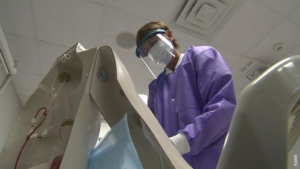The Silent Threat: How Hepatitis Spreads
Hepatitis is a silent and often misunderstood disease that affects millions of people worldwide. While the word itself may conjure up images of a deadly epidemic, the reality is that hepatitis is a quiet threat that can silently spread from person to person. In this article, we will explore the various ways in which hepatitis is transmitted and shed light on the importance of raising awareness about this often overlooked disease.
1. Bloodborne Transmission: The Vampire Connection
One of the primary modes of hepatitis transmission is through exposure to infected blood. Just like vampires, the hepatitis viruses sneak into the bloodstream and wreak havoc on the body. This can occur through sharing needles, receiving contaminated blood transfusions, or even getting a tattoo or body piercing with unsterilized equipment. Bloodborne transmission is particularly common among intravenous drug users and healthcare workers who may come into contact with infected blood.
2. Sexual Transmission: The Secret Passions
Another surprising way in which hepatitis can spread is through sexual contact. The viruses responsible for hepatitis can be found in semen or vaginal fluids, and engaging in unprotected sex with an infected person increases the risk of transmission. This is why it is crucial to have open conversations about sexual health and to practice safe sex to prevent the spread of hepatitis and other sexually transmitted infections.
3. Mother-to-Child Transmission: The Unbreakable Bond
A bond between a mother and her child is unbreakable, but unfortunately, hepatitis can pass from mother to child during childbirth. This mode of transmission, known as perinatal transmission, can occur if the mother is infected with hepatitis B or C. However, there is hope as this transmission can be prevented with proper medical interventions such as antiviral therapy and vaccination of the newborn.
4. Contaminated Food and Water: The Culinary Connection
While hepatitis is primarily a bloodborne and sexually transmitted disease, certain types of hepatitis can also be transmitted through contaminated food and water. Hepatitis A, in particular, is commonly spread through the consumption of food or water that has been contaminated by the fecal matter of an infected person. This highlights the importance of practicing good hygiene and ensuring the safety of food and water sources to prevent the spread of hepatitis.
Post
Post
5. The Silent Carrier: Asymptomatic Transmission
Perhaps one of the most concerning aspects of hepatitis is that infected individuals may not show any symptoms, yet they can still transmit the virus to others. This asymptomatic transmission can occur through various means, including close personal contact, sharing personal items such as toothbrushes or razors, or even through tiny amounts of infected blood entering open cuts or wounds. This silent carrier phenomenon underscores the need for regular screenings and testing to identify individuals who may unknowingly be spreading the virus.
While the methods of hepatitis transmission may seem daunting, it is important to remember that knowledge is power. By understanding how hepatitis spreads, we can take proactive measures to prevent its transmission. Through education, vaccination, safe practices, and early detection, we can work together to overcome this silent threat and protect the health and well-being of individuals around the world.



